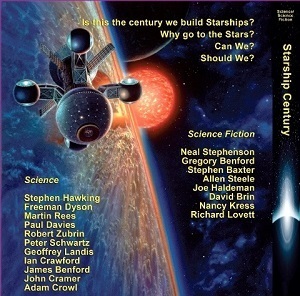Paul Gilster's Blog, page 222
July 9, 2013
‘A Terrible Beauty’ Among the Stars
Martin Rees’ ideas on how humans will adapt to starflight, discussed here yesterday, offer plenty of ground for speculation and good science fiction. After all, the path ahead forks in many directions, one of them being the continuing development of artificial intelligence to the point where ‘artilects’ rather than humans become the logical crew for star missions. If decades or even centuries are needed to cross to another system, then this gets around the problem of keeping people sane and cooperating across what might be generations of voyaging.
Another fork is biological, with humans being gradually engineered to make them more adaptable to environments they’ll find at their destination. Here we can imagine crews sent out in some kind of deep hibernation, their biology tweaked to allow a ready transition to the new planet. Or perhaps cyborg solutions suggest themselves, with humans augmented by digital technologies to deal with problems and interface directly with critical shipboard computer systems.

I always think of Freeman Dyson when speculating about these things because back in 1985, he lectured in Aberdeen on a one kilogram deep space probe that would be as much biological as mechanical, a genetically engineered symbiosis of animal, plant and electronics. Dyson saw the animal component as providing sensors and nerves and muscles for basic operations and navigation, while electronics dealt with communications and data return. The plant component offered a closed-cycle biochemistry fed by sunlight. Artificial intelligence would integrate all operations in a probe he described as ‘agile as a hummingbird, with a brain weighing no more than a gram.’
You can read about the concept in Dyson’s Infinite in All Directions (Harper & Row, 1988), and you might pair it with Anders Hansson’s paper “Towards Living Spacecraft,” which ran in the Journal of the British Interplanetary Society in 1996. In the same Starship Century volume as the Martin Rees essay is Dyson’s latest thinking on the matter, a lively piece called “Noah’s Ark Eggs and Viviparous Plants.” Like Rees, Dyson is captivated with the tools that molecular biology is giving us and sees them as a way to seed the universe with life, turning inhospitable venues into living worlds [video].
After all, we are now learning the language of the genome and have sequenced the genomes of several thousand species. As the speed of such sequencing increases and the costs decline, it will take no more than twenty years or so to sequence the genomes of all species now existing on our planet. It turns out that describing the entire biosphere does not take up all that much space. In fact, Dyson writes, the information content of the biosphere genome comes to something on the order of one petabyte, which is less than the amount of data held by Google. “The biosphere genome,” he writes, “could be embodied in about a microgram of DNA, or in a small room full of computer memory disks.”
The larger vision here is that we can’t talk about permanent human settlement away from Earth unless we learn how to grow complete ecosystems in remote places. Here’s the concept:
It is not enough to have hotels for humans. We must establish permanent ecological communities including microbes and plants and animals, all adapted to survive in the local environment. The populations of the various species must be balanced so as to take care of each others’ needs as well as ours. Permanent human settlement away from Earth only makes sense if it is part of a bigger enterprise, the permanent expansion of life as a whole. The best way to build human habitats is to prepare the ground by building robust local ecologies. After life has established itself with grass and trees, herbivores and carnivores, bacteria and viruses, humans can arrive and build homes in a friendly environment. There is no future for humans tramping around in clumsy spacesuits on lifeless landscapes of dust and ice.
But Dyson doesn’t stop at the kind of worlds we would consider suitable for humans. He’s talking about going well beyond this, designing biosphere populations that can survive in environments ranging from planetary moons to comets. He imagines future bioengineers designing biosphere genomes for such places (these are the Noah’s Ark Eggs of his title) and seeding them in venues like the outer Solar System, where warm-blooded plants that can collect energy from sunlight would begin the process of building an ecosystem. Many biospheres would fail but those that survived would evolve in unpredictable ways as they adapt to small, cold places without atmospheres. You can see that Dyson’s emphasis is on life at large, not just humans.
How would you engineer a warm-blooded plant? Dyson thinks even objects as distant as the Kuiper Belt could become homes for life if we can do something like this:
Two external structures make warm-blooded plants possible, a greenhouse and a mirror. The greenhouse is an insulating shell protecting the warm interior from the cold outside, with a semi-transparent window allowing sunlight or starlight to come in but preventing heat radiation from going out. The mirror is an optical reflector or system of reflectors in the cold region outside the greenhouse, concentrating sunlight or starlight from a wide area onto the window. Inside the greenhouse are the normal structures of a terrestrial plant, leaves using the energy of incoming light for photosynthesis, and roots reaching down into the icy ground to find nutrient minerals.
Comets have plentiful sources of carbon and oxygen along with nitrogen and other key elements. Sunlight at a distance of 100 AU is reduced by a factor of ten thousand, but even the human eye can concentrate incoming light onto a spot on the retina by a factor larger than a million. So Dyson is arguing that a mirror as precise as a human eye could keep a plant warm at distances even further out than the Kuiper Belt. These self-grown mirrors would, like sunflowers, track the Sun as it moves across the sky. Plants like these would also be viviparous, with the seeds developing into viable plants before being dispersed into the frigid waste around them.
Stop being provincial, Dyson is telling us: Instead of focusing on how to find or re-create exactly Earth-like conditions wherever you go, think about helping life itself to spread into environments where it does not now exist. Give life this chance and let evolution take over to lead where it will. Seeding the universe may lead to places utterly incapable of supporting people like us, but extend the tools of molecular biology far enough and the explorers of the far future may adapt themselves to the environments they have shaped. ‘A terrible beauty is born,’ Yeats once wrote about a different kind of transformation, but in that beauty may lie habitats for new beginnings.






July 8, 2013
Starflight: Engagement with Risk
How we’ll go to the stars is often a question we answer with propulsion options. But of course the issue is larger than that. Will we, for example, go as biological beings or in the form of artificial intelligence? For that matter, if we start thinking about post-human intelligence, as Martin Rees does in the recently published Starship Century, are we talking about reality or a simulation? As the Swedish philosopher Nick Bostrom has speculated, a supremely advanced culture could create computer simulations capable of modeling the entire universe.
Rees recapitulates the argument in his essay “To the Ends of the Universe”: A culture that could create simulations as complex as the universe we live in might create virtual universes in the billions as a ripe domain for study or pure entertainment, allowing a kind of ‘time travel’ in which the past is reconstructed and the simulation masters can explore their history. So there we have a play on the nature of reality itself and the notion that our perceptions are constricted — as limited, Rees says, “as the perspective of Earth available to a plankton whose ‘universe’ is a spoonful of water.’

It’s a mind-blowing thought and Rees uses it to point out that our concepts of physical reality may need adjustment. What engages him about post-human evolution, though, isn’t the simulation speculation as much as the idea that genetic modifications and a simultaneous advance in machine intelligence will allow the kind of ‘directed’ evolution we’ll need if we are to expand into colonies beyond Earth. Here’s the argument compacted into a paragraph:
Darwin himself realised that ‘No living species will preserve its unaltered likeness into a distant futurity.’ We now know that ‘futurity’ extends much farther, and alterations can occur far faster than Darwin envisioned. And we know that the cosmos, through which life could spread, offers a far more extensive and varied habitat than he ever imagined. So humans are surely not the terminal branch of an evolutionary tree, but a species that emerged early in the overall roll-call of species, with special promise for diverse evolution — and perhaps of cosmic significance for jump-starting the transition to silicon-based (and potentially immortal) entities that can more readily transcend human limitations.
Humanity’s Special Moment?
Rees thinks we are at a special moment in time, a century that is the first occasion when the fate of the entire planet is in the hands of a single species. It’s also the century when we have the capability of starting the expansion of human life into the rest of the Solar System and beyond. This thought will recall Rees’ 2003 book Our Final Century (published in the US as Our Final Hour), whose subtitle says it all: ‘A Scientist’s Warning: How Terror, Error, and Environmental Disaster Threaten Humankind’s Future In This Century – On Earth and Beyond.’ There follows a study of the risk factors that hang over our culture’s head.
Which do you think would be the most likely cause of our demise? The possibilities are legion, ranging from environmental collapse to biological terrorism or the inadvertent results of using new technology, perhaps in the release of nanotechnology that goes out of control. The argument in the essay is similar to the book, that we have the ability to surmount these problems if we are wise enough to expand the frontiers of science and of exploration. The outcome is by no means certain but I think the picture may look darker than it really is, for while we can see the problems Rees outlines emerging, we cannot know what new knowledge we will gain as we confront them that will make solutions possible. Put me, then, on the more optimistic side of Rees’ speculations, a space the Astronomer Royal dwells on in this essay.
Let’s assume, then, that the outcome is indeed human survival and movement into space. That calls for near-term solutions to re-energizing the global space effort. How do we avoid the blunders of the past, the failure to follow up the Apollo landings with a credible and sustained program to continue manned exploration? The answer may well lie in private funding:
Unless motivated by pure prestige and bankrolled by superpowers, manned missions beyond the moon will need perforce to be cut-price ventures, accepting high risks — perhaps even ‘one-way tickets.’ These missions will be privately funded; no Western governmental agency would expose civilians to such hazards.
Here, of course, we think of Inspiration Mars, the plan to send a crew of two on a Mars flyby with launch in 2018, or the Dutch Mars One program, in which settlers would go to Mars knowing they would not be returning. Rees continues:
There would, despite the risks, be many volunteers — driven by the same motives as early explorers, mountaineers, and the like. Private companies already offer orbital flights. Maybe within a decade adventurers will be able to sign up for a week-long trip round the far side of the Moon — voyaging farther from Earth than anyone has been before (but avoiding the greater challenge of a Moon landing and blast-off). And by mid-century the most intrepid (and wealthy) will be going farther.
On Risk as Necessity
That scenario winds up with human outposts scattered through the Solar System, beginning with Mars or, perhaps, the asteroids. The post-human era may begin as we bring genetic engineering to bear on making ourselves more adaptable to such radically alien environments. A parallel development in artificial intelligence will make it an open question whether our forays beyond the Solar System are conducted by human or machine or a mixture of both. Given the time-scales involved in interstellar journeys, any human crews would be heavily modified, but it’s more likely that they will be non-biological entities altogether, adapted for long and solitary exploration.
Is interstellar travel possible? The answer may well be yes, but for whom? Rees’ point is that the options will grow as we gain experience with the new environments we explore. SETI may help us find extraterrestrial intelligence, but maybe not. Either way, evolution into the post-human era will be driven by the imperative to protect — and extend — the species. Whether or not such extension leads in the course of millennia to a Kardashev Type III civilization, actively shaping the fate of its entire galaxy, will depend at least in part upon our ability to transcend the kind of existential risks Rees discusses in Our Final Century.
Where I disagree with Rees is in the implication that, the risks of our century being solved, we will have transcended them. Risk survival is a continual process activated by the very breakthroughs in technology and exploration the astrophysicist here explores. We can only imagine what kind of dangers a rapidly growing starfaring culture would expose itself to purely in terms of its own engineering, not to mention its possible encounters with other civilizations.
Our encounter with risk has always been a precondition for our encounter with life, making the 21st Century a bit less unique than Rees would have it, but no less significant for the opportunity it offers to re-evaluate and once again engage the inevitable risks of growing starward.






July 5, 2013
Red Dwarfs: Clouds in the Habitable Zone
How close can a planet be to its star and still be habitable? If by ‘habitability’ we mean liquid water on the surface, with whatever consequences that may bring on a particular world, then it’s clear that the answer is partially dependent on clouds. We’ve developed one-dimensional models that can study the effect of clouds in various exoplanet environments, but they’re unable to predict cloud coverage, location or altitude. A new paper now describes a three-dimensional model that can make such calculations about atmospheric circulation, with interesting results.
Focusing on planets around M-class dwarf stars, Jun Yang and Dorian Abbot (both of the University of Chicago) and Nicholas Cowan (Northwestern University) are quick to note that red dwarfs like these constitute perhaps 75 percent of all main sequence stars. Current data (based on the work of Courtney Dressing and David Charbonneau) suggest that there is an abundance of Earth-size planets in the habitable zone — one per star — around M-dwarfs. The close orbits and deep transit depth of planets in the habitable zone here make them relatively easy to detect.
Yang, Abbot and Cowan put their model to work looking at the effect of water clouds on the inner edge of the habitable zone, with results showing that clouds can have a significant effect on cooling the planet, allowing liquid water to exist much closer to the star than was previously believed. Assuming M-dwarf planets close enough to be in the habitable zone will be tidally locked — with one side always facing the star — the team shows that the side of the planet exposed to the star would develop highly reflective clouds at the ‘sub-stellar’ region directly below the sun’s position in the sky.
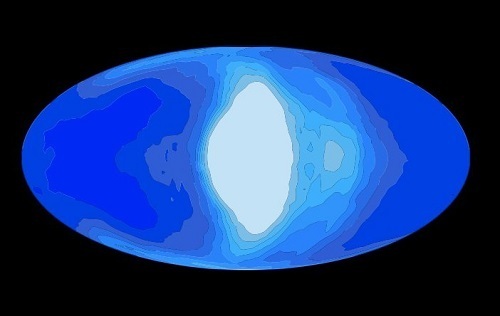
Image: This illustration shows simulated cloud coverage (white) on a tidally locked planet (blue) that would be orbiting a red dwarf star. Credit: Jun Yang.
‘High noon’ on an M-dwarf world, in other words, should produce clouds that have a significant cooling effect. Just how significant an effect is revealed in the paper’s conclusions:
We have performed the first 3D global calculations of the effect of water clouds on the inner edge of the HZ and predict that tidally locked Earth-like planets have clement surface conditions at twice the stellar flux calculated by 1D models. This brings already detected planets, such as HD 85512 b and GJ 163 c, into the HZ, and dramatically increases estimates of the frequency of habitable planets. Adopting the planetary demographics from Figure 19 of Dressing & Charbonneau (2013), our revised inner edge of the HZ increases the frequency of habitable Earth-size planets by at least 50–100%. Crucially, we have also shown how this stabilizing cloud feedback can be tested in the near future with thermal phase curves from JWST.
The behavior of clouds on planets that are not tidally locked is going to be markedly different. The researchers believe that such worlds will have an albedo (reflectivity) similar to Earth’s because only part of the tropics and the mid-latitudes will be covered with clouds and the water content of the clouds will be small. But tidal lock produces clouds with high water content covering between 60 and 80 percent of the dayside, according to these models. The thickest clouds occur where light from the star is the most intense, thereby significantly increasing the albedo of the planet.
Such clouds, under conditions described in the paper, account for 73 K of cooling, thus extending the habitable zone despite the planet’s proximity to the star. What I like about this work is the possibility of testing it in the near-term using the James Webb Space Telescope, with which we can measure the temperature of M-dwarf planets at different points in their orbit. A planet without cloud cover will show its highest temperatures when the dayside is facing the telescope (with the planet on the far side of the star). Temperatures would be lowest when the planet comes around in its orbit to show its dark side to the telescope.
But a planet with highly reflective clouds on the dayside will be different, says Jun Yang:
“…you would measure the coldest temperatures when the planet is on the opposite side, and you would measure the warmest temperatures when you are looking at the night side, because there you are actually looking at the surface rather than these high clouds.”
This University of Chicago news release points out that we can see the same effect on Earth when looking at places like Brazil or Indonesia from space. An infrared instrument will find unusually cold conditions when it observes the cloud deck, which is at high altitude. Temperature variations of this kind from an exoplanet around an M-dwarf would indicate clouds and confirm the presence of liquid water on the surface. Thus three-dimensional simulations of the way air and moisture move through the atmosphere extend the potential habitable zone in the star’s direction.
The paper is Yang, Cowan and Abbot, “Stabilizing Cloud Feedback Dramatically Expands the Habitable Zone of Tidally Locked Planets,” Astrophysical Journal Letters, Vol. 771, No. 2, July 10, 2013 (abstract / preprint).






July 3, 2013
Focus on the Sail
The British geneticist and biologist J.B.S. Haldane has left us with one of the more memorable lines about scientific inquiry, one that draws on the richest of all of Shakespeare’s plays for its punch. Hamlet tells Horatio that there are more things in heaven and Earth than are dreamt of in his philosophy (Act 1, Sc. 5), a thought Haldane adapts in the service of intellectual surprise. In his collection Possible Worlds and Other Essays (1927), he writes:
I have no doubt that in reality the future will be vastly more surprising than anything I can imagine. Now my own suspicion is that the universe is not only queerer than we suppose, but queerer than we can suppose … I suspect that there are more things in heaven and earth than are dreamed of, or can be dreamed of, in any philosophy.

We can imagine Olaf Stapledon nodding as he read those lines. Haldane sketched out a human history covering the coming 40 million years in his essay “The Last Judgement,” one that Stapledon drew on in creating his own Last and First Men (1930). We can also imagine the reader surprise that probably met Haldane’s use of solar sails as a way of getting around the Solar System, all part of the same essay, in which Venusian colonists (after the demise of the Earth) contemplate crossing to a passing star on beams of the Sun’s light.
Image: John Burdon Sanderson Haldane (1892–1964), who gives us one of our earlier references to solar sails as a way of reaching the stars.
In Defense of the Sail
These days we have seen solar sailing in action through the Japanese IKAROS mission and the smaller NanoSail-D project from NASA, even as larger sails have been constructed for ground tests and we look forward to a late 2014 launch of NASA’s Sunjammer, which will deploy a sail 38 meters on a side (the sail’s name comes from an Arthur C. Clarke story that envisioned a race to the Moon using solar sails, one that ends with the abandoned ship being targeted for interstellar space). Solar sails, in other words, are not — like fusion, like antimatter — propulsion systems of the future. They’ve reached flight status for deployment and testing in space.
These sails work because light, although it has no mass, can impart momentum. If we can make the necessary upgrades in materials to enable a close pass by the Sun (perhaps with the aid of an occulter to shield the craft at perihelion), we can imagine driving a sail deep into the Solar System at speeds of several hundred kilometers per second. But as Jim Benford shows in his essay “Sailships” in Starship Century, we need to go much faster for an interstellar mission, and that involves beaming energy that will produce force at great distances.
From the essay:
I say this because sailships have a singular advantage: they leave the engine behind. So we can build a spacecraft that consists of only payload and structure — no fuel at all. The propellant is light itself, so sails reflect light waves, whether visible or microwave or laser produced, from a beam generated elsewhere. Sails can be made both light and smart, in the sense that control systems, sensors and computational ability can be embedded in the structure of the sail itself — a smart sail, with dispersed circuitry, and therefore far harder to damage by meteors or accident.
All this makes a solid case for sail technologies, and so does the fact that in the year 2000, Benford and his brother Gregory produced laboratory data showing that carbon sails could be driven by microwave beams to produce accelerations of several g’s. When I wrote about this work in Centauri Dreams (the book), I was struck by the fact that this laboratory work demonstrated beam-riding, in which the pressure of the beam and the concave shape of the sail work together to produce a sideways restoring force. The sail can also be stabilized against yaw and drift because the beam being directed at it can carry angular momentum that can be imparted to the spacecraft, thus spinning it.
Near-Term Work on Beamed Power
Benford looks at issues of stability, deployment and large-scale space construction for sails and the beam sources that drive them, all of which demand a stable infrastructure to build upon. But the fact that we already have sails capable of space deployment points toward building experience with sail engineering and in particular materials as we learn to optimize our work with carbon nanotubes and carbon micro-truss structures. It’s an intriguing thought that, sails being large structures we will learn to work with in space, their growth should also help in the development of large transmitting antennae of the kind we will eventually need to build.
A stair-step series of beamed power applications builds the groundwork for the sail infrastructure, one that grows out of engaging commercial interests:
In today’s frugal climate, it is important for technology development to be coupled to commercial applications. Several of the missions we’ve described are potentially commercial matters. Starting with orbital debris mapping, one can see an incremental commercial development leading first to satellite power recharging. Eventually, as the space market and business confidence grows and capital becomes more available, this development plan leads to the repowering of satellites in GEO and ultimately to launch services. Investment costs are minimized because the research program leads to applications, which feed capital back into research, leading to new applications.
Ultimately, we’d like to build a true beamer — the source of the laser or microwave beam we’re sending to the sail — that would be assembled in space from materials mined from the moon or from asteroids. Placing the beamer in a close solar orbit would maximize the power available. The beauty of the beamed energy concept is obvious: Early fusion designs like Daedalus could carry a payload that was less than one percent of its initial mass, while sailship payload masses can be considerably higher. After all, we’re leaving the propellant behind us in the Solar System. Moreover, a single beamer, once established, could be used for many sailship missions.
Imagine, then, future sails many kilometers in diameter that are deployed by spinning up the initial, folded package and, in close proximity to the beamer, are pushed out by laser or microwave beam. The acceleration quickly increases as the beam stays fixed on the sail for hours, then days. As the sailship reaches the outer Solar System, the beam switches off and the spacecraft is launched on its interstellar journey, perhaps stowing the sail for cruise. The fact that electromagnetic waves can transfer power over long range makes this scenario possible.
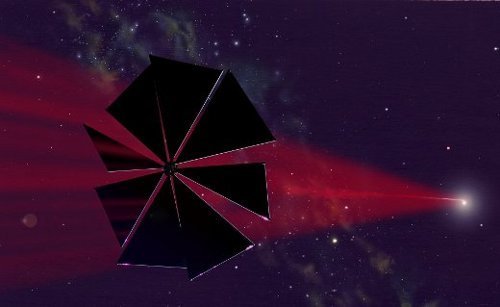
Image: An interstellar sail pushed by laser or microwave. Credit: Michael Carroll.
Fusion, Benford notes, is still struggling with physics and engineering issues, so that cost estimates for continued research and development are wide open. If the idea is to solve the physics, then tackle the engineering questions and finally look at the economic feasibility, then sails have the edge. We know the basic physics and have an engineering requirement that demands large antenna and optical arrays, along with assembly of our photon sources. Usefully, we have considerable experience in the sub-systems that are a foundation of this work.
We often think of beamed sail concepts in terms of gigantic structures like the Fresnel lens that Robert Forward wrote about in the outer Solar System, thousands of kilometers in diameter and massing half a million tons, or his 75,000 ton staged laser sails destined for Epsilon Eridani. But researchers like Geoffrey Landis have gone to work on Forward’s concepts using high-temperature materials like boron and carbon that would allow better acceleration, and proposing a string of lenses that would drastically reduce the size of the Fresnel lens.
The theoretical work continues as we press on with our early sail deployments. J.B.S. Haldane had no doubt that the future would surprise him, and doubtless the fiction of Olaf Stapledon took his thoughts in directions he could never have anticipated. We will learn in the coming century whether the audacious idea of a sail being pushed between the stars is another Haldane whim that nudges our philosophy, pointing to a workable approach to crossing the interstellar gulf.






July 2, 2013
Into the Literature of Starflight
Tracking down starflight in literature is an absorbing pastime. When I was writing my Centauri Dreams book, I found that I was vaguely familiar with many of the antecedents of today’s science fictional journeys, but a book called Wunderwelten, by Friedrich Wilhelm Mader, took me by surprise. A 1911 adventure novel for young readers, Wunderwelten imagines a sphere that, in the fashion of the time’s space fiction, was moved by antigravity in a multi-year journey to Alpha Centauri. Mader’s ship, called ‘Sannah,’ was a precursor to all the Centauri-bound starships to come.
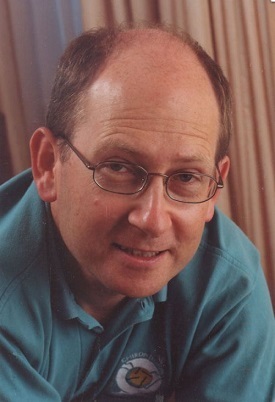
What a delight to find Sannah emerge in the form of Sannah III in Stephen Baxter’s story “Star Call,” which appears in the recently published Starship Century. But Baxter’s updated ship is a far cry from the 50-meter antigravity vessel imagined by Mader. For one thing, it’s gifted with artificial intelligence:
I am called Sannah III because I am the third of four copies who were created in the NuMind Laboratory at the NASA Ames research base. I was the one who was most keen to volunteer for this duty. One of my sisters will be kept at NASA Ames as backup and mirror, which means that if anything goes wrong with me the sentience engineers will study her to help me. The other sisters will be assigned to different tasks. I want you to know that I understand that I will not come home from this mission. I chose this path freely. I believe it is a worthy cause.
Image: Science fiction novelist Stephen Baxter, who has revived Mader’s antique starship.
Sannah’s cause, and the thinking around it, are regularly reported back to Earth as it travels, all by means of the Star Call system, which allows people to buy a share in the mission and in return get once-a-decade message exchanges with the starship. A poignancy in these communiques emerges that reminds me of Greg Bear’s sentient starship in Queen of Angels as we begin to realize the mission is not going well and Sannah may not have all the facts.
Emergence of Pellet Propulsion
Interestingly, the stardrive on Sannah is not antimatter but what Baxter dubs a ‘Singer-Nordley-Crowl’ drive after Clifford Singer, who studied pellet propulsion technologies back in the late 1970s. The Nordley reference is to Gerald Nordley, whose own pellet propulsion methods revised and significantly upgraded Singer to allow for ‘smart pellets’ with course correction. Crowl, of course, is our own Adam Crowl, who has been writing and commenting on this site almost since its inception, and whose own entry in Starship Century is a comprehensive look at how researchers have envisioned starships in our time.
Adam, serious congratulations, buddy. I mean, to have a stardrive named after you…
Nordley was interested in nanotechnology and proposed that the problems of getting small particles moving at relativistic speeds to their target (where they would push against its magnetic field to drive it forward) could be handled by artificial intelligence and minute rockets. ‘Smart pellets’ wouldn’t be easy to send on their way but nanotechnology worked there as well. Says Crowl:
To power either system would require immense solar power-collection systems, which Nordley proposed to be built via self-replicating machines. Optimistically assuming a single self-replicating power-satellite that supplies one gigawatt of power that copies itself in a year, then within mere decades sufficient power would be available to propel a 1,000-ton starship to 0.86c at five-Gs, and a decade later a thousand such starships could be propelled per year.
0.86c is an interesting figure. Nordley told me in an interview years back that he thought the first human crew to reach Alpha Centauri would get there after a journey lasting about three years. That’s three years as experienced by the crew. Moving at 0.86c, he added, those aboard the starship would experience a time compression factor of two — half as much time would expire for them as would expire for the people left behind on Earth. Add in acceleration and deceleration time and you get the result, a three year passage (as perceived by those onboard) to the nearest star. It’s about the same amount of time it took Magellan to circumnavigate the Earth.
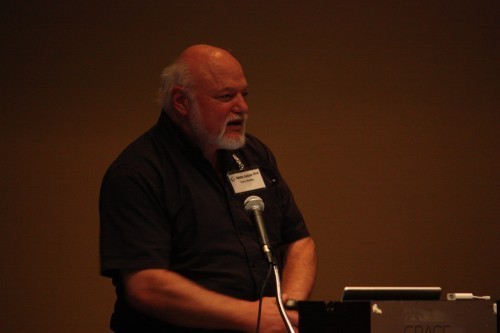
Image: Interstellar researcher Gerald Nordley, speaking at the Space Access 2010 Conference in Phoenix, Arizona.
Interactions with the Medium
Crowl’s paper runs through all the starship concepts I’ve ever encountered, among the most fascinating of which are the lesser known. Back in the 1970s, for example, as NASA studied the possibility of pushing a probe up to interstellar speeds using lasers, Philip C. Norem and Robert Forward went to work on the question of how to slow down a probe for rendezvous. One of Forward’s sail deceleration concepts was ingenious enough to merit separate treatment, and I’ll talk about it tomorrow as we discuss Jim Benford’s ideas on laser and microwave sails. But there are other ways of doing these things, and Norem and Forward found that a starship could be turned by using large charged wires to interact with the galactic magnetic field.
The key to this is the fact that a charged object moving through a magnetic field experiences a Lorentz force at right angles to its direction of motion and the magnetic field itself. If you give it enough time to work, the Forward/Norem method can actually slow a probe down and turn it so that it approaches the target star (from our perspective on Earth) from behind. At that point a laser beam from Earth could be trained on the starship’s sail to slow it for the rendezvous. The same method could be used in reverse to enable a return journey. The main problem is that the large turning circles require centuries of additional travel time to pull off the feat.
Both Forward and Norem were fascinated by the concept of ‘thrustless turning,’ written up by Norem in a 1969 paper. I’ll mention another aspect of this that may be germane here, a 2005 paper by Gregory Matloff and Les Johnson that studies how to use the interstellar medium not for turning but for generating power aboard the spacecraft. This could be done through the interactions between an electrodynamic tether and the interstellar magnetic field.
We might throw Freeman Dyson into the mix as well. Dyson studied propellantless braking after observing the magnetic interactions between the large inflatable satellites of the early 1960s and the plasma around them. A starship using these methods to decelerate would release electromagnetic energy that might be observable, thus allowing a search for extraterrestrial space vehicles. Crowl discusses what Dyson called Alfven braking in relation to magnetic sail concepts that emerged in the late 1980s. And it’s to sails, though not magnetic ones, that I want to turn tomorrow as we ponder Crowl’s many propulsion alternatives.
The Philip Norem paper is “Interstellar Travel: A Round Trip Propulsion System with Relativistic Capabilities,” AAS 69-388 (June, 1969). Robert Forward’s paper on Lorentz force turning is “Zero-Thrust Velocity Vector Control for Interstellar Probes: Lorentz Force Navigation and Circling,” AIAA Journal 2 (1964), pp. 885-889. Gregory Matloff and Les Johnson write about electrodynamic tether possibilities in “Applications of the Electrodynamic Tether to Interstellar Travel,” JBIS 58 (June, 2005), pp. 398-402. Cliff Singer’s first pellet paper is “Interstellar Propulsion Using a Pellet Stream for Momentum Transfer,” JBIS 33 (1980), pp. 107–115.






July 1, 2013
Starship Century: A Review of the Book
Could there be a more time-worn trope in science fiction than the arrival of colonists or explorers on a new world? The stage is set for adventure and the unwinding of whatever plot theme the author has in mind, but if the planet is Earth-like, we see the colonists quickly settling in, adapting to local conditions and, in relatively short order, creating a new society. Back in the 1950s the film When Worlds Collide showed the arrival of desperate survivors of a doomed Earth on a planet that would be their refuge, the assumption being that from this point on, everything would be no more difficult than setting up a camp on some new continent.
Would it be so? For that matter, would our human crew be able to survive the journey? Paul Davies has his doubts, and he expressed them forcefully at the recent Starship Century event in San Diego. While we tend to concentrate on time and distance problems — how do you get something moving fast enough to get your crew to another star within a human lifetime? — Davies is more concerned with long-term survival and the creation of a truly self-sustaining ecosystem, not to mention what happens to that ecosystem when it mixes with its counterpart on an alien world.
A huge part of the conundrum has to do with microbes. They account for almost all terrestrial species and thrive absolutely everywhere, down to kilometers below the surface. As Davies points out, microbes form a network of biological interactions that we know all too little about, into which are woven the equally complicated activities of viruses. We wind up with an ecological web of a complexity that defeats our best attempts at modeling. Thus the problem:
In the absence of sending the entire terrestrial biosphere, a fundamental unsolved problem arises: what is the minimum complexity of an ecosystem — dominated, as I have explained, by microbes — necessary for long-term sustainability? At what point, as more and more microbial species are dropped from the inventory of interstellar passengers, does the remaining ecosystem go unstable and collapse? Which microbes are crucial and which would be irrelevant passengers as far as humans (and their animal and plant food supply) are concerned?
Davies’ thoughts on this ‘Noah’s Ark conundrum,’ as he calls it, form the basis of his contribution to the Starship Century book, and you can see a video of his talk in San Diego online. The problem he outlines is one that won’t go away, for if we do solve the propulsion problem, what happens when we get light years from Earth only to discover that we left a bacterium behind that makes all the difference in keeping us alive? For that matter, can we predict how a sustainable ecosystem survives and changes in conditions of extreme long-term isolation?
The Fiction of Science
It’s one of the strengths of this collection of essays and short stories that it interweaves the science fictional impulse with the science. Thus Davies’ conjectures are anticipated by Richard Lovett’s story “Living Large,” which sketches a multi-century journey to the stars through the eyes of one of its future crew. Problems with closed-loop ecologies form the basis of the crew member’s interview with a journalist anxious to communicate starflight realities to the public, with all that means about radiation issues, efficiency in food production, recycling of nutrients and the rest. Through Lovett we see some of Davies’ key points illuminated in a tale that grew out of Lovett’s own thoughts on adapting to changing and ultimately alien ecosystems.
It was Freeman Dyson who said “Science is my territory, but science fiction is the landscape of my dreams.” Many of us, even those who do not claim science as native turf, can second that assertion about science fiction and dreaming. It is the sheer audacity of science fiction to take us out of the conventional world and into alternative possibilities that are vividly realized and challenge us to question our assumptions. Thus Nancy Kress’ “Knotweed and Gardenias,” a cautionary tale about a deep space mission whose crew begins to show behaviors that are inexplicable. Can they find the one thing mission planners left out of their own artificial ecosystem?
Readers with a taste for Heinlein will take huge pleasure in seeing a rough and vigorous future sketched out in Gregory Benford’s “The Man Who Sold the Stars,” a lively tale whose title makes a nod to Heinlein’s “The Man Who Sold the Moon.” Like Heinlein’s Delos Harriman, Benford’s Harold Mann is driven by his own inner compulsions to make things bigger, better and more innovative than ever before, creating a series of business breakthroughs that range from nanotech applications in orbit to asteroid mining, high-tech profit hunting all in the service of an innate drive to push boundaries or, as Mann says, “Man’s got to throw long in this life.”
“If you’re young and lean,” Harold’s future wife tells him, “things can fail and you still keep going. For the big space companies, the whole competition is just getting the government contract, then it’s all risk aversion. It’s not at all about doing something cool, first to market, then making money so you can do more. That is what I like: not playing it safe. To shift gears, to follow your nose.”
As indeed she does in a lifetime with steadily expanding technologies that eventually take her and her husband on an improbable journey to the nearest star. Along the way the roadblocks thrown by bureaucrats, hostile competitors and public indifference are progressively overcome, and we watch the development of a Solar System infrastructure enabled by the production of nuclear thermal rockets that become the Conestoga wagons of an expanding spaceward push. But as the tale shows, it takes more extreme measures when the distances become interstellar.
An Industrialized Solar System
Geoffrey Landis, a crack science fiction writer who also favors this book with a poem, puts the focus on nuclear thermal technologies in an essay that explains the limitations of the chemical rocket and the technologies that can surmount it [video]. Both Landis and Adam Crowl touch on these matters, with Crowl offering a comprehensive overview of starship ideas in the literature — more about the Crowl essay later this week — while Landis homes in tightly on a technology that’s exceedingly simple. Gas is moved over a hot reactor core, to be expanded and pushed out a nozzle to produce thrust. Landis calls it the “spaceship equivalent of a pickup truck.”
Interesting outer system scenarios emerge in the consideration of rocket fuel:
Water is abundant in the outer system… After all, once you get far from the Sun — roughly past the middle of the asteroid belt — water ice is just another kind of rock. Closer in to the Sun, many asteroids have water as part of their composition in the form of water of hydration. So you can refuel your nuclear rocket using hydrogen generated from harvesting rocks in the Trojan asteroids, or short period comets — and, since you have a transportation system, you can haul fuel wherever you need it in the inner Solar System as well. You can either use electrolysis to split out the hydrogen for reaction mass — or, if you want higher thrust but can afford lower performance, you can use water (or ammonia — another ice common in the outer reaches of the Solar System) as the reaction mass.
Thus we get the space-age ‘Silk Road’ trading routes of space, with our craft going out to the outer system, gathering up the water to split into hydrogen and oxygen, and bringing it into the inner system. Our ships return from the outer dark laden with fuel, water for life support and the myriad uses of industrial processing. Landis runs through the history of nuclear thermal designs at NASA, considering the NERVA (Nuclear Energy for Rocket Vehicle Applications) work of the 1960s that produced designs (and tests on) a number of nuclear rockets. Including the Rover program, NASA did 28 full-power test firings of nuclear engines at the Jackass Flats test site in Nevada. We’ve never flown them, but these rocket engines have been thoroughly tested.
Landis’ thoughts on a bi-modal rocket, one that uses the heat of the nuclear core when high thrust is needed and otherwise taps nuclear power to run an ion engine, show us the kind of rocket that might one day colonize the Solar System. Just how nuclear thermal fits into the wider panorama of deep space propulsion concepts is something we’ll be talking about in coming days not only with Jim Benford’s thoughts on solar and beamed-sail missions but also with a long look at Adam Crowl’s survey of interstellar concepts, ideas that range from fusion through sails and into exotic possibilities like particle beam propulsion and interstellar ramjets. I also want to discuss Martin Rees’ thoughts on where we are going and revisit Freeman Dyson’s provocative speculations about what might happen at the edge of the Solar System.
The Case for Deep Space
Two other titles that meld science and science fiction come quickly to mind, the first being Project Solar Sail, a 1990 book edited by Arthur C. Clarke, and the more recent Going Interstellar, edited by Les Johnson and Jack McDevitt. Starship Century puts an exclamation point on the idea with a series of thought provoking essays and compelling science fiction tales that link thematically to the idea of building a pathway that will eventually take us to interstellar flight through wise use of Solar System resources.
With authors like Martin Rees, Freeman Dyson, Neal Stephenson, David Brin and John Cramer, the ideas fly, and it was delightful to see an old favorite, Joe Haldeman’s “Tricentennial,” reprinted long after its 1976 appearance in Analog (and also delightful to see that it has lost none of its punch). The profits for Starship Century go toward “experiments, theory and concept studies” involving interstellar flight at a time when interest in space-related technologies seems to be surging, as witness the success of Planetary Resources’ recent fundraising, and the suddenly burgeoning series of upcoming conferences which includes Starship Congress in Dallas this August as well as the 100 Year Starship Symposium in Houston this September. Starship Century should further ramp up public interest. It is a provocative cri de coeur that belongs on the shelf of anyone with an interest in starflight.






June 28, 2013
Catching Up with FOCAL
Michael Chorost has written a fine essay on Claudio Maccone’s FOCAL mission concept for The New Yorker blog. Centauri Dreams regulars will know Chorost from several previous posts here, particularly a discussion on SETI that I talked about in On Cosmic Isolation, where he analyzed the hunt for extraterrestrial civilizations in terms of problems of perception, with reference to his own thoughts on deafness, cochlear implants and neurotechnology. Mike is the author of the superb World Wide Mind (Free Press, 2011) that examines the interface between future humans and future machines.
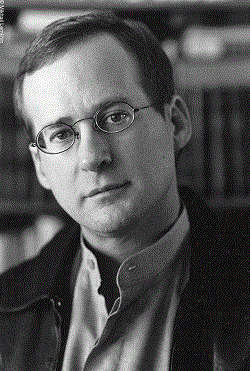
I also like to remind readers of something Mike wrote on his own blog last year, which refers to a book I deeply admire and issues I’ll be writing about in future essays here. In particular, how do we deal with advanced alien civilizations if we run across them, and would the gap between us and them defeat our attempts at communication? Chorost takes a positive view:
I’d like to be optimistic. I’d like to think we’d be better off than preliterates puzzling over Wikipedia on an iPad. In his book The Beginning of Infinity, David Deutsch argues that humans crossed a crucial threshold with the scientific method. We now know that everything is explainable in principle, if we make the effort to understand it. Arthur C. Clarke famously said that any sufficiently advanced technology will seem like magic. This may be true, but we will not mistake it for magic. We have a postmodern openness to difference, a future-oriented culture, and well-established methodologies for studying the unknown. Our relative horizons are much larger than our ancient ancestors’ were.
More on all these issues in last year’s post SETI: Contact and Enigma. For today, though, some thoughts about the FOCAL mission, which envisions sending a probe out past 550 AU, the distance at which light is bent around the Sun by its gravity to form a gravitational lens. I say ‘beyond 550 AU’ because the focal line goes to infinity, and also because at 550 AU itself, we have severe coronal distortion effects to deal with, so a FOCAL mission, if the technology and the science check out to make it happen, would begin its observations further out and would keep traveling as it made them.
Lensing and Technology
We’ve seen recently –and Chorost writes about this — that there is to be an attempt to examine Proxima Centauri for planets because of an upcoming gravitational lensing event. The star will pass in front of a far more distant star in October of 2014, and an analysis of that event may flag the presence of small planets that have thus far eluded detection. Maccone, of course, has been arguing since the early 1990s that we can stop waiting for chance observational occurrences and start exploiting the gravitational focus with a directed mission. His book Deep Space Flight and Communications (Springer, 2010) is an analysis of mission possibilities.
My conversations with Claudio Maccone about FOCAL go back to one of Ed Belbruno’s New Trends in Astrodynamics and Applications conferences at Princeton in 2005, where Greg Matloff, his wife C and I had breakfast with Claudio and, over orange juice, coffee and a stack of enormous pancakes, talked about the problems and potential solutions for getting the mission to work. Since then the indefatigable Maccone has worked tirelessly on the issues and in his new book discusses, among other things, the kind of antenna deployment such a probe would use, and the prospects for using gravitational lensing not only for astronomical observations but communications.
Chorost had numerous exchanges with Maccone for this piece and does an admirable job at making the basics clear to a lay audience. He’s particularly interested in SETI possibilities, something out of which the initial FOCAL work grew through meetings in Italy in the 1990s that examined the kind of missions that could be run using solar sail technologies. From the essay:
Maccone wants to use the sun as a gravitational lens to make an extraordinarily sensitive radio telescope. He did not invent the idea, which he calls FOCAL, but he has studied it more deeply than anyone else. A radio telescope at a gravitational focal point of the sun would be incredibly sensitive. (Unlike an optical lens, a gravitational lens actually has many focal points that lie along a straight line, called a focal line; imagine a line running through an observer, the center of the lens, and the target.) For one particular frequency that has been proposed as a channel for interstellar communication, a telescope would amplify the signal by a factor of 1.3 quadrillion.
Could we actually build such a craft and, having sent it on its journey to a place roughly five times as far as Voyager 1 has reached to begin observations, untangle the information it sent us? We’re pushing theory and technology hard and have much to do with both before we can be sure it will work. For that matter, when Mike asked me how we could get Maccone’s payload into this kind of trajectory within the lifetime of a human researcher, I had to say that with present-day methods, we’d be limited to a solar sail (perhaps with a close solar pass to boost acceleration) or nuclear-electric technologies that might be used in conjunction with such a sail.
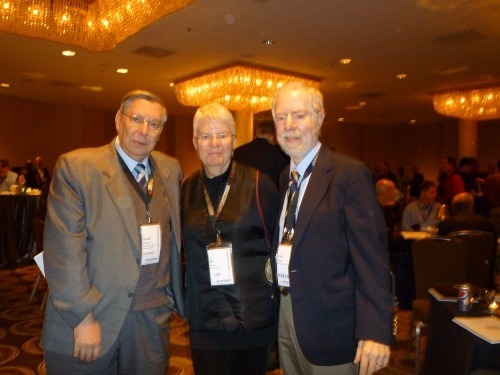
Image: Claudio Maccone (left), Jill Tarter and myself at the 100 Year Starship conference last year in Houston. What an evening that was, and yes, FOCAL was a major topic when Claudio and I had dinner the next evening. Thanks to Thomas Hair for snapping this.
But then what? Long-time readers will know of my admiration for A. E. van Vogt’s short stories (his novels, alas, are another matter, although I have a lingering fondness for The Weapon Shops of Isher). In particular, the story “Far Centaurus,” which ran in the January, 1944 issue of Astounding, sticks with me because its Centauri-bound crew finds the destination already settled by people who had left long after them on faster ships. So if a 50-year FOCAL mission is enabled by sail or hybrid technologies, can we guarantee that twenty years after launch, we won’t have something better — a fusion option, perhaps — that will pass the initial mission along the way?
It’s always a tradeoff, and the fact is that we could have waited before sending our Voyagers to the edge of the Solar System. If we had, we’d still be waiting, because it’s proving mighty hard to come up with that next big propulsion breakthrough due to funding limitations and perceived lack of public enthusiasm for major space projects. New Horizons is arcing toward Pluto/Charon and at one point was moving a bit faster than Voyager 1, but the Sun’s gravity has slowed it back down, leaving the intrepid Voyager 1 at 17.1 kilometers per second as our fastest moving object.
Or, I should say, ‘our fastest moving object that is departing the Solar System,’ since we’ve been able to get solar probes like Helios up to faster speeds. In any case, FOCAL is one of those mission concepts that, like Innovative Interstellar Explorer, demand innovative thinking and a serious gut-check in terms of what is possible and what we want to do. For me, the scope of the challenge makes it all the more fascinating to study such missions. Pushing hard at our limits awakens creative thought and suggests unexpected options in a future that is anything but foreordained.






June 27, 2013
Asteroids in our Future
NASA has released an Asteroid Initiative Request for Information on the issue of asteroid retrieval. It’s an interesting document both in its audience — the agency is making a point about soliciting comments not only from academics, scientists and engineers but the general public — but also because of the issues it explores. Being sought are ideas on how best to capture an asteroid, land an astronaut on one, and change its orbit, not necessarily in that order. The Los Angeles Times quotes NASA associate director Robert Lightfoot on the public component of NASA’s initiative:
“Too often, by the time we present a mission to the public, it has already been baked, and there’s not much we can change. This is your chance to present your ideas to us before the mission is baked.”
If you’re interested in contributing, move quickly, for the deadline for responses is July 18, with a workshop to follow in September.
The creation of a Solar System-wide infrastructure will necessarily precede any interstellar probes, if only because the methods we are studying to make such a probe happen all involve large construction projects in interplanetary space and resource retrieval from places as far away as the gas giants. But making the early infrastructure viable could well be the result of asteroid activities through companies like Planetary Resources and Deep Space Industries, or whoever manages to sustain an economic model for exploiting these interesting objects.
Asteroids are compelling targets for mining everything from gold, iron, nickel and platinum to water that can be extracted to support human settlements. But the case for developing our asteroid capabilities is also wrapped up in planetary defense, and it’s interesting to see this section of the NASA RFI:
Asteroid Deflection Demonstration: NASA is interested in concepts for deflecting the trajectory of an asteroid using the robotic Asteroid Redirection Vehicle (ARV) that would be effective against objects large enough to do significant damage at the Earth’s surface should they impact (i.e. > 100 meters in size). These demonstrations could include but [are] not limited to: a. Use of the ARV to demonstrate a slow push trajectory modification on a larger asteroid. b. Use of the ARV to demonstrate a “gravity tractor” technique on an asteroid. c. Use of ARV instrumentation for investigations useful to planetary defense (e.g. sub-surface penetrating imaging) d. Use of deployables from the ARV to demonstrate techniques useful to planetary defense (e.g. deployment of a stand alone transponder for continued tracking of the asteroid over a longer period of time).
10,000 NEOs and Counting
All of this is wrapped up inside the larger agency effort to capture and de-spin an asteroid and redirect it into translunar space, as described in the document. Just after the release of the NASA Request for Information on June 18, we learned that the 10,000th near-Earth object, asteroid 2013 MZ5, was detected by the Pan-STARRS-1 telescope in Hawaii. Near-Earth objects (NEOs) can approach the Earth’s orbital distance within 45 million kilometers. Known NEOs are as large as 40 kilometers (1036 Ganymed) or as small as a meter in diameter. Asteroid 2013 MZ5 turns out to be about 300 meters across and is not in an orbit that is considered hazardous.
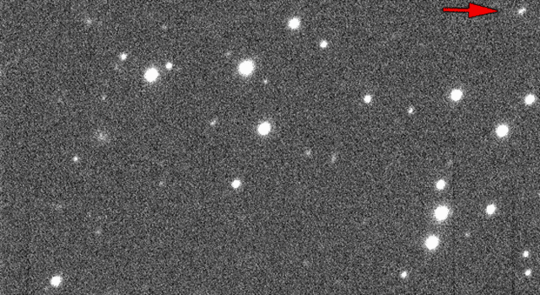
Image: Asteroid 2013 MZ5 as seen by the University of Hawaii’s PanSTARR-1 telescope. In this animated gif, the asteroid moves relative to a fixed background of stars. Asteroid 2013 MZ5 is in the right of the first image, towards the top, moving diagonally left/down. Credit: PS-1/UH.
I’ve been reading Don Yeomans’ book Near-Earth Objects: Finding Them Before They Find Us (Princeton University Press, 2012), an excellent overview of the field that I’ll be reviewing here in coming weeks. In this JPL news release Yeomans, manager of NASA’s Near-Earth Object Program Office at JPL, comments on the overall effort to track down NEOs:
“The first near-Earth object was discovered in 1898. Over the next hundred years, only about 500 had been found. But then, with the advent of NASA’s NEO Observations program in 1998, we’ve been racking them up ever since. And with new, more capable systems coming on line, we are learning even more about where the NEOs are currently in our solar system, and where they will be in the future.”
A glimpse of that future is provided by Lindley Johnson, who is part of NASA’s Near-Earth Object Observations Program. Johnson notes the significance of finding the 10,000th NEO but adds “…there are at least 10 times that many more to be found before we can be assured we will have found any and all that could impact and do significant harm to the citizens of Earth.” So we keep looking. NASA expects there are about 15,000 NEOs that are 140 meters in size and more than a million that reach 30 meters. The latter is a figure the agency cites as being the minimum size needed to cause ‘significant devastation’ in populated areas.
The news release has this to say about the NEOs we’ve already discovered:
Of the 10,000 discoveries, roughly 10 percent are larger than six-tenths of a mile (one kilometer) in size – roughly the size that could produce global consequences should one impact the Earth. However, the NASA NEOO program has found that none of these larger NEOs currently pose an impact threat and probably only a few dozen more of these large NEOs remain undiscovered.
The Near-Earth Object Observations Program is indeed, as Yeomans says, ‘racking them up.’ Working through the Catalina Sky Survey, the University of Hawaii’s Pan-STARRS survey and MIT’s LINEAR survey, NEOs are being discovered at a rate of about 1,000 per year. All observations flow to the Minor Planet Center in Cambridge MA in an effort that is clearly making progress on finding and cataloging objects. We now need to emphasize the effort to study the kind of deflection and trajectory-altering techniques NASA describes in the new RFI.






June 26, 2013
Philosophy, Intention and GJ 667C
The star Gliese 667C is as intriguing as it is because it underlines in triplicate the ‘habitability’ question, which surfaces every time a planet is discovered in a zone around its star where liquid water could exist on the surface. This is the classic definition of ‘habitable zone,’ meaning not so much a place where humans could live — we have no knowledge of other conditions on these worlds, knowing little more than their minimum mass — but a place where a basic condition for life as we know it is possible.
I’m much in favor of considering exotic environments for life, and these would include venues ranging from the upper clouds of Venus to the depths of the icy gas giant satellites in our own system. But when we read about ‘habitable zones’ in most scientific papers, we’re usually falling back on the liquid water criterion because it’s hard enough to search for any kind of life on a distant world, much less a kind that we don’t even know exists. Liquid water is a starting point, a baseline in the search for life-supporting worlds, but it hardly means the hunt for life stops there.
My own speculations about systems like GJ 667C become purely imaginative. I notice how many systems we’re finding that have ‘super-Earths,’ a category of planet that doesn’t even appear in our own Solar System. I also note that small M-dwarfs can produce clusters of planets that, in the case of GJ 667C, are close enough that three can be squeezed into the habitable zone. Imagine a civilization emerging on one such world, with other possible life-bearing planets so tantalizingly close — what a boost that would give to the proponents of the local space program!
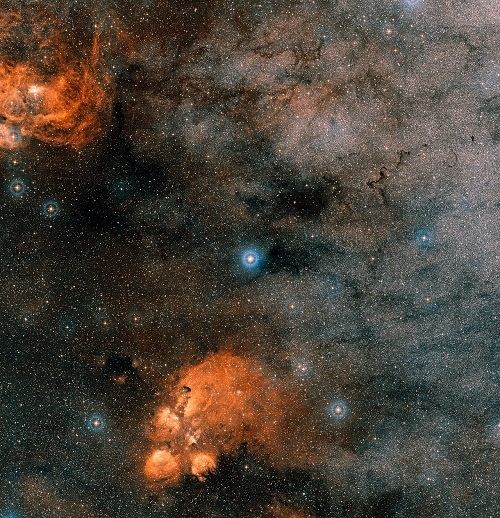
Image: This picture shows the sky around multiple star Gliese 667. The bright star at the centre is Gliese 667 A and B, the two main components of the system, which cannot be separated in this image. Gliese 667C, the third component, is visible as a bright star, very close and just under A and B, still in the glare of these brighter stars. The very subtle wobbles of Gliese 667C, measured with high precision spectrographs including HARPS, revealed it is surrounded by a full planetary system, with up to seven planets. Credit: ESO/Digitized Sky Survey 2. Acknowledgement: Davide De Martin.
Searching for Life’s Equations
In Are We Alone, a fine essay in Aeon Magazine, astrobiologist Caleb Scharf (Columbia University) places the exoplanet hunt in a cosmic context. We may be getting used to them now, but the early proliferation of ‘hot Jupiters’ and now ‘super-Earths’ was not an expected outcome at the beginning of exoplanet detection — for that matter, the pulsar planets found around PSR B1257+12 in 1991 certainly raised eyebrows as orbiting the remnant of a once massive star. Scharf points out, too, that 70 Virginis b and 16 Cygni Bb, discovered not long after the detection of planets around 51 Pegasi in 1995, were moving on highly elliptical orbits.
These wonderful finds — and news like GJ 667C delivered yesterday — keep reminding us that the old idea that our Solar System is somehow representative of what we’ll find elsewhere is deeply flawed. Says Scharf:
Many exoplanets… follow orbits that are far more elliptical than any followed by the major planets around our Sun. More puzzling still, the most frequent type of configuration, the one that has earned the moniker of ‘the default mode of planetary formation’, is that of closely packed worlds, on orbits that take mere days or weeks to loop around their stars. These compressed versions of our own system seem, for now, to be far more normal than our own. But if we’re not normal, what are we? That’s a question we can’t answer yet, because our census of stars and planets is still woefully incomplete.
Back to the habitability question. With the prospect of tens of billions of stars in our galaxy harbouring planets of Earth-size and into the super-Earth range, we live in a universe that gives us the chance to find out whether life is rare or common. Being in a habitable zone does not mean a planet sustains life, and it will be the job of our next-generation instruments to help us study planetary atmospheres so we can unlock the numbers on just what the odds are. Scharf speaks of an ‘equation for abiogenesis’ that we can search for throughout a galaxy that accommodates us by giving us a vast number of targets. We can thus take a measure of our own significance:
If we lived in a cosmos with only a few planets, we could never deduce the true probability of abiogenesis with any precision, even if they all harboured life — as imagined by earlier advocates of plurality. We might never be lucky enough to find one of these worlds within examining range, and all would be lost among the stellar fields of the Milky Way. The existence of billions of planets gives us a chance to write the equation, a chance to pin down the relationship between habitability and actual habitation.
So the excitement of finds like the planets around GJ 667C isn’t that we have yet more evidence that clement places for life can exist in the cosmos. It’s that we have another target — at 22 light years a relatively close one — that we’ll eventually be able to use as we make the crucial call on life’s equations. In the coming century, a discovery in either direction, that life is a rarity or is as common as, well, planets in the habitable zone, will have profound implications for philosophy as well as practical action. It will guide our intentions as we develop the technologies to reach other stars






June 25, 2013
Gliese 667C: Three Habitable Zone Planets
Gliese 667C keeps getting more interesting. In the past we’ve looked at studies of this star in a triple system just 22 light years away, work that had identified three planets around the star. As one of these was in the habitable zone, this small red dwarf (about a third of the Sun’s mass) quickly engaged the interest of those thinking in terms of astrobiology. Now we get news that GJ 667C may actually host up to seven planets, with three evidently in the habitable zone.
I would say Mikko Tuomi (University of Hertfordshire, UK) is guilty of a bit of understatement. He’s quoted in this ESO news release thusly:
“We knew that the star had three planets from previous studies, so we wanted to see whether there were any more. By adding some new observations and revisiting existing data we were able to confirm these three and confidently reveal several more. Finding three low-mass planets in the star’s habitable zone is very exciting!”
Exciting indeed — we’ve never found three super-Earths within the same star’s habitable zone, in this case a realm closer to the parent star than the planet Mercury in our system. The work drew on data from the UVES spectrograph on ESO’s Very Large Telescope (Chile), as well as the Carnegie Planet Finder Spectrograph at the Magellan II site in Chile, the HIRES spectrograph on the 10-meter Keck instrument on Mauna Kea, and previous data from the HARPS (High Accuracy Radial velocity Planet Searcher) on the ESO 3.6-meter instrument in Chile.
What we wind up with after a thorough analysis of the radial velocity data for GJ 667C are five signals described by ESO as ‘very confident,’ with a sixth signal that is tentative and a seventh that is more tentative still. From the paper:
– – Up to seven periodic signals are detected in the Doppler measurements of GJ 667C data, being the last (seventh) signal very close to our detection threshold.
– The significance of the signals is not affected by correlations with activity indices and we could not identify any strong wavelength dependence with any of them.
– The first six signals are strongly present in subsamples of the data. Only the seventh signal is unconfirmed using half of the data only. Our analysis indicates that any of the six stronger signals would had been robustly spotted with half the available data if each had been orbiting alone around the host star.
A Densely Packed Habitable Zone
The habitable zone here is found to lie between 0.095–0.126 AU and 0.241–0.251 AU. Two planets exist on the star-side of the habitable zone, three within it, and the last two further out in the system. The assumption here, echoed by ESO, is that all five of the inner planets including the three in the habitable zone are tidally locked, with one side in permanent sunlight and the other in darkness. The skies above one of the habitable zone planets could present an interesting view indeed, as the ESO artist’s impression below conveys.
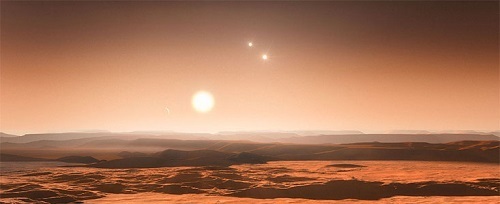
I want to look more closely at the author’s conclusions on the three habitable zone planets, starting with planet c, which is closer to the inner edge of the HZ than the Earth is in our system. Global climate here would depend upon the properties of the atmosphere:
If the atmosphere is thin, then the heat absorbed at the sub-stellar point cannot be easily transported to the dark side or the poles. The surface temperature would be a strong function of the zenith angle of the host star GJ 667C. For thicker atmospheres, heat redistribution becomes more significant. With a rotation period of ∼ 28 days, the planet is likely to have Hadley cells that extend to the poles (at least if Titan, with a similar rotation period, is a guide), and hence jet streams and deserts would be unlikely. The location of land masses is also important. Should land be concentrated near the sub-stellar point, then silicate weathering is more effective, and cools the planet by drawing down CO2 (Edson et al. 2012)….
The authors describe planet f as ‘a prime candidate for habitability’:
It likely absorbs less energy than the Earth, and hence habitability requires more greenhouse gases, like CO2 or CH4. Therefore a habitable version of this planet has to have a thicker atmosphere than the Earth, and we can assume a relatively uniform surface temperature. Another possibility is an “eyeball” world in which the planet is synchronously rotating and ice-covered except for open ocean at the sub-stellar point (Pierrehumbert 2011).
And finally, about planet e, which receives:
…only a third the radiation the Earth does, and lies close to the maximum greenhouse limit. We therefore expect a habitable version of this planet to have > 2 bars of CO2. The planet might not be tidally locked, and may have an obliquity that evolves significantly due to perturbations from other planets. From this perspective planet e might be the most Earth-like, experiencing a day-night cycle and seasons.
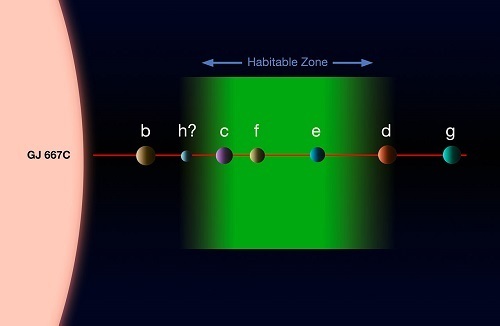
Image: This diagram shows the system of planets around the star Gliese 667C. A record-breaking three planets in this system are super-Earths lying in the zone around the star where liquid water could exist, making them possible candidates for the presence of life. This is the first system found with a fully packed habitable zone. The relative approximate sizes of the planets and the parent star are shown to scale, but not their relative separations. Credit: ESO.
Nature of the Super-Earths
As to the composition of the super-Earths around GJ 667C, the authors note the ‘packed configuration’ of the system, with all planets inside 0.5 AU, and go on to say:
…the planets either formed at larger orbital distances and migrated in (e.g. Lin et al. 1996), or additional dust and ice flowed inward during the protoplanetary disk phase and accumulated into the planets Hansen & Murray (2012, 2013). The large masses disfavor the first scenario, and we therefore assume that the planets formed from material that condensed beyond the snow-line and are volatile rich. If not gaseous, these planets contain substantial water content, which is a primary requirement for life (and negates the dry-world HZ discussed above). In conclusion, these planets could be terrestrial-like with significant water content and hence are potentially habitable.
Is GJ 667C the first among many M-dwarf systems containing several potentially habitable worlds each? The authors speculate that this is the case, and if that is so, then we may ultimately learn that life is more common on worlds around these small red dwarfs than around any other class of star. It’s a notion worth thinking about, given that M-dwarfs make up perhaps as much as 80 percent of the stellar population.
It’s worth mentioning that this study includes a reanalysis of earlier data that underlines the growing power of our archived observations to inform new work. Thus Guillem Anglada-Escudé (University of Göttingen), who worked with Tuomi on this project: “These new results highlight how valuable it can be to re-analyse data in this way and combine results from different teams on different telescopes.” The new tools of digital storage and analysis mean that we are gathering data at a clip far beyond what we can exhaustively analyze, meaning that surprises may await in numerous datasets when weighed against hints from new studies.
The paper is Anglada-Escudé et al., “A dynamically-packed planetary system around GJ 667C with three super-Earths in its habitable zone”, accepted for publication in Astronomy & Astrophysics.






Paul Gilster's Blog
- Paul Gilster's profile
- 7 followers


